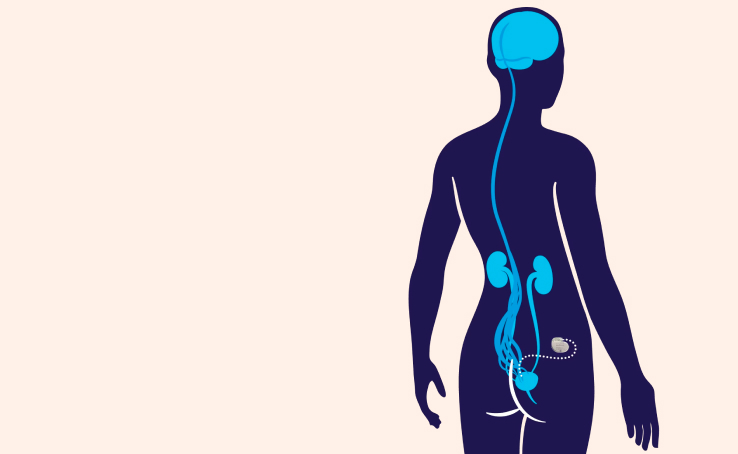Share your medical reports and get an exclusive offer tailored to your needs, requirements and preferences
Avg Price: $ 15000-$ 30000


Treatment Time
Recovery Time
Hospitalization Days
Success Rate
Overactive Bladder (OAB) and faecal incontinence (FI) are two distinct but interlinked disorders that have a substantial influence on people's quality of life. These illnesses are more widespread than is widely recognised, despite the fact that they are often buried in secrecy and stigma.
OAB syndrome, affecting 11–19% of the global population, emerges as a barrier that obstructs social and daily activities like employment, travel, exercise, sleep, and sexual function. Urinary and faecal incontinence commonly coexist, particularly in the elderly. Around 30% of people over 65 suffer from such conditions. It may have an earlier impact on a woman's life than a man and affects more women than men.
Interstim Therapy has emerged as a game-changing therapeutic option with a ray of hope for those who have problems with bowel and bladder control. This novel FDA approved strategy attempts to improve the quality of life of patients suffering from illnesses such as overactive bladder (OAB), urine retention, and faecal incontinence.
With a high degree of expertise and understanding in the discipline of neurosurgery, India is home to about 1800 neurosurgeons. Various national institutions, including All India Institute of Medical Sciences (AIIMS), National Institute of Mental Health and Neurosciences (NIMHANS), and Postgraduate Institute of Medical Education and Research have exemplary infrastructure and training programmes.
Moreover, multiple state-of-the-art corporate hospitals with extensive infrastructure and indisputable reputation reflect a huge potential of India to provide high end nerve treatments. Therefore, it is becoming easier every year to get the best doctor for interstim therapy and the best hospital for interstim therapy in India.
Overactive Bladder is a Disorder that is characterised by sudden and frequent urges to urinate, resulting in urinary incontinence (the unintentional leakage of urine). Even if their bladder isn't full, people with OAB may feel a sensation of urgency that can be challenging to regulate. Because it can disrupt daily activities, social relationships, and emotional health, this disorder can have a major negative impact on a person's quality of life.
Faecal incontinence is the involuntary loss of bowel control that causes unintentional faeces discharge. This disorder can cause periodic slight stool leaks to total lack of bowel control. It can be difficult for people to seek care because faecal incontinence is frequently underreported and stigmatised.
Muscle dysfunction, nerve issues, progressing age, child births, and chronic conditions like diabetes or neurological disorders can be responsible for damaging bladder and bowel control.
Take Charge of Your Health
Book a Free Consultation

For those with Overactive Bladder (OAB) and faecal incontinence (FI), Interstim Therapy, also known as Sacral Neuromodulation, is a cutting-edge and successful therapeutic option. The goal of Interstim Therapy is to improve bladder and bowel control by stimulating the sacral nerves to modify the communication between the Brain, Spinal Cord, and Pelvic Organs.
Pre-evaluations allow patients to test the interstim therapy to determine its efficacy, allowing them to make an informed decision with their physician about whether to proceed with implantation. In general, the examination is considered successful if the patient reports a considerable (50% or greater) decrease in symptoms and improved bladder and bowel control. The procedures included in evaluation appointment are:
1. Complete medical history review
2. Thorough physical examination
3. MRI & CT scan of the sacral spine
4. Basic Evaluation: It involves peripheral nerve evaluation which is typically used for bowel and bladder control evaluation. It involves a simple procedure through which the lead is placed in the upper buttock. This lead is connected to an external neurostimulator that the patient wears on a belt for up to 7 days (depending on physician guidance). The patient is told to complete a symptom diary that is eventually compared to a baseline (symptom diary prior to the evaluation).
5. Advanced Evaluation: It begins with an outpatient procedure in a hospital or surgical centre. During this evaluation, the patient again wears an external neurostimulator for up to 14 days (depending on physician supervision). Symptom diaries are used to track progress.
Your Health is Our Priority
Book a Free Consultation
After a successful trial during pre-evaluation with at least 50% clinical improvement in bowel and bladder control, the internal pulse generator (IPG) is implanted. To implant the IPG, the area of the previous gluteal incision is expanded and opened. The lead is inserted directly into the neurostimulator head of IPG. Because IPG dislocation is rare and to prevent a pulling or tugging sensation, it is often not sutured in the pocket. For device stabilisation and infection control, an antimicrobial mesh bag is sutured into the pocket.
Like any medical therapy, InterStim Therapy has possible dangers and drawbacks. Before choosing the therapy, it's critical to have a thorough awareness of these potential concerns:

In order to promote good healing, reduce complications, and maximize the therapeutic efficacy of Interstim Therapy to improve bowel and bladder control, post-procedure care is essential. Following are a few general recommendations for post-procedure care:
Wound Care: Following surgery, the surgical site will be covered with a bandage. Avoid removing or replacing the dressing. Keep the site clean.
Post-surgical pain management: Even though it is natural to feel some discomfort after surgery, the stimulation shouldn't cause much pain. Under medical supervision, take painkillers to get relief.
Stimulation: The "pulling" or "tingling" sensation felt in the pelvic region, which is close to the vagina, scrotum, or anal area, is called stimulation. It shouldn't cause pain at all. Reduce the stimulation if it hurts or if you feel the sensation of stimulation spreading down your legs. Then, reach out to your doctor immediately.
Physical activity: For 14 days following surgery, refrain from intense activities or heavy lifting. For two weeks following each surgery, only use a frontal shower or sponge bath. Wait till your post-operative appointment before immersing yourself in any water.
Symptoms to report: Reach out to your care provider if you experience severe or worsening of pain, high fever, chills, sweats, discomfort during urination, or device issues.
Avail the Expert Health Advice
Book a Free Consultation
People who get Interstim devices are able to accomplish things they couldn't do before, such take leisurely strolls through parks, see films in theatres or travel with significantly improved bowel and bladder control. You may need some time to become used to the therapy, but you should soon be ready to resume your regular activities. Following are the certain things that should be kept in mind:
Almost 80 percent of patients who received interstim therapy reported at least a 50 percent improvement in their leakage problems and bowel and bladder control in comparison to almost 50 percent of those who are on medication for overactive bladder. Patients experienced three times better improvement in their quality of life than ones who were taking medication for the same.
However, the success of the treatment largely depends on underlying medical condition, patient selection, and the skill and experience of the healthcare provider performing the procedure. As medical research and technology continue to advance, the success rates of this therapy might evolve over time.
The cost of Interstim Therapy can vary widely based on several factors, including the specific medical facility, location, healthcare provider fees, insurance coverage, the type of interstim device used, and any additional medical services or follow-up appointments required.
However, the average cost of interstim therapy in India is approximately
$ 25,000 to ₹
$ 30,000 which is fairly economical when compared to treatment costs in developed countries. There its starting cost is more than 20 lakhs.
The common drivers of the overall cost of Interstim Therapy are due to the following factors:
The cost of diagnostics of Interstim Therapy for overactive bladder or faecal retention may include various preoperative evaluations and tests that are typically conducted before the surgical procedure. It mainly requires an MRI and CT scan of the sacral spine.
MRI scans of the spine might cost between 3000-8000 rupees and CT scan of spine might cost you between 3000-6000 rupees in India. However, the cost of these scans is determined by the scan type and machine quality (1.5 or 3 Tesla). Therefore, the total diagnostic expenses (including facility fees, specialists’ fees, and diagnostic tests) will be roughly around 30,000 INR.
The price of a diagnostics for this procedure varies significantly depending on the following factors:
MedFlick, your trusted healthcare companion, is dedicated to ensuring that your medical journey goes as smoothly and successfully as possible.
Fostering expertise backed by commitment, resilience and years of experience, we connect you to a wide network of India's best doctors
Explore the most advanced, reputable and trusted hospitals in India, offering the highest levels of clinical and surgical excellence

The worlds most trusted personalized health community with more than 1,00, 000 members that share their journey, experiences and health insights. Join your community and get access to make informed health decisions.
Explore


